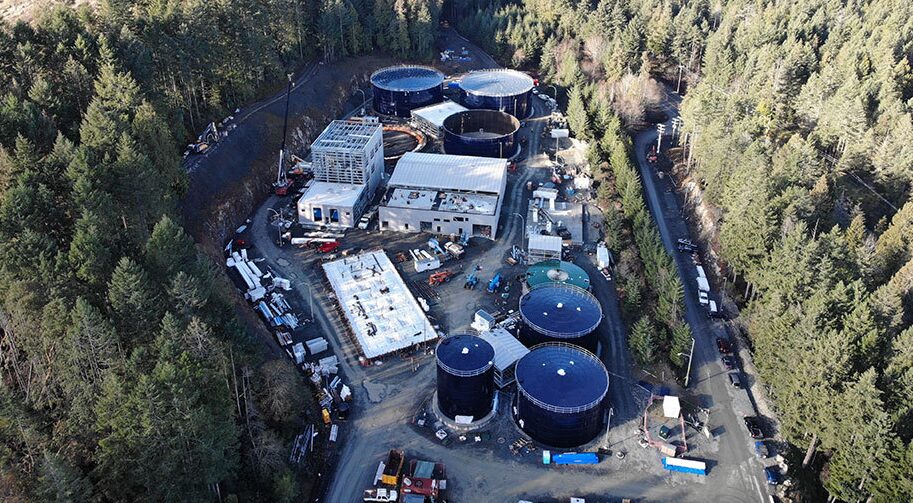Courtesy of the Capital Daily
Photo: Synagro’s Residuals Treatment Facility at Hartland Photo: Synagro
Under pressure from the province, the CRD needs to come up with a definitive plan to deal with the mounting quantity of dried biosolids pellets at Hartland. Biosolids are the byproduct of the region’s wastewater treatment processes. As of now, the CRD says the region’s biosolids are being landfilled “under emergency measures.”
Its website indicates that a biosolid management pilot project could begin in the initial months of 2026, pending provincial approval and public support. For the sake of transparency, the CRD engaged in virtual public consultation on Feb. 20 and an online survey up to March 6 on the subject.
Delaware-based Synagro Technologies is the largest recycler of organic byproducts in North America. It is also the majority equity holder in the residual treatment facility at Hartland Resource Management Group (HRMG), a group that also includes Bird Construction and Maple Reinders. The price tag for Synagro to build its residual treatment facility at Hartland was $12.6M. The contract it negotiated to produce Class A biosolids for the CRD is for 20 years.
According to CRD procurement policy, all competitive bid documentation must include a section that requires suppliers to disclose any actual or potential conflicts of interest and existing business relationships it may have with the CRD, its elected or appointed officials, or employees prior to submission of the bid.”
The CRD claims it learned of a Texas farmer’s lawsuit brought forward in February against Synagro the following month, in March. Member Phillipe Lucas says the matter was brought to its attention not by Synagro, but by the Peninsula BioSolids Coalition at a meeting on Feb 8.
In their suit Farmer v. Synagro Tech., Inc. Texas farmers are seeking damages, including more than $75K after the product was applied to their lands in 2022. In the civil suit, the plaintiffs claim their farms were polluted by toxic chemicals in a biosolids-based fertilizer produced by Synagro after a neighbouring property spread the product on its crops.
The farmers allege the fertilizer contained high levels of PFAS (per-and polyfluoroalkyl substances)
that made them sick with various illnesses, led to some of their animals dying, polluted their water, and rendered their properties worthless. While ingestion is the most common route of toxic exposure, researchers are finding that inhalation and absorption through the skin are also significant routes of exposure to PFASs.
Logically, Phillipe Lucas wants to know if the CRD has asked Synagro if there is any material difference between the technologies and chemical constituents that it uses in Texas and the technology used here to produce bio-solids.
“We worked closely with our partners to develop a facility that will process residuals using proven advanced digestion and thermal technology to produce a Class A biosolids product,” Pam Racey, Synagro vice-president of project development said at the time of the CRD contract announcement.
Coun. Jeremy Caradonna told Capital Daily “In theory, what is supposed to matter is the class of biosolids. Class A is Class A, so it’s reasonable to assume, in my view, that whatever toxins are found in The Texan Class A biosolids are likely to be found here. But that would require verification.”
Synagro Technologies continues to assert their products did not harm Johnson Country Texas farmers or make their animals sick. PFASs are considered “forever chemicals” that have been linked to cancer, several diseases, and other harmful impacts on humans and animals.
If the Texas case appears too far removed, in the case of Organic Producers Assn. of Cawston & Keremeos v. British Columbia the BC Environmental Appeal Board found that a permit issued by the province allowing the use of biosolids as fertilizer did not ensure the protection of the environment as per the requirements under BC’s Waste Management Act (WMA).
“You can have a very high level of toxicity or danger even when you’re doing a regulated application of Class A biosolids. To me, that reinforces our concern,” Lucas said.
Through its Forest Fertilization program, the CRD has been sending biosolids up-Island and they have been applied to lands approximately 12km northwest of Nanaimo, off Weigles Road. Recently, the forest fertilization program moved to a new site near an area known as Blackjack Ridge.
As a former Nanaimo resident, Lucas is concerned about potential contaminants from those biosolids leaching into the Nanaimo Lakes and river that are just a few hundred metres from the Blackjack site.
In the short-term, the CRD intended for KENES trucking to transport the biosolids to the Lafarge cement plant in Richmond where it would be burned in a co-combustion-to-heat process in its cement kilns.
After reaching out to the WSANEC Leadership Council and Lafarge, it remains unclear to Capital Daily whether that transport is happening.
